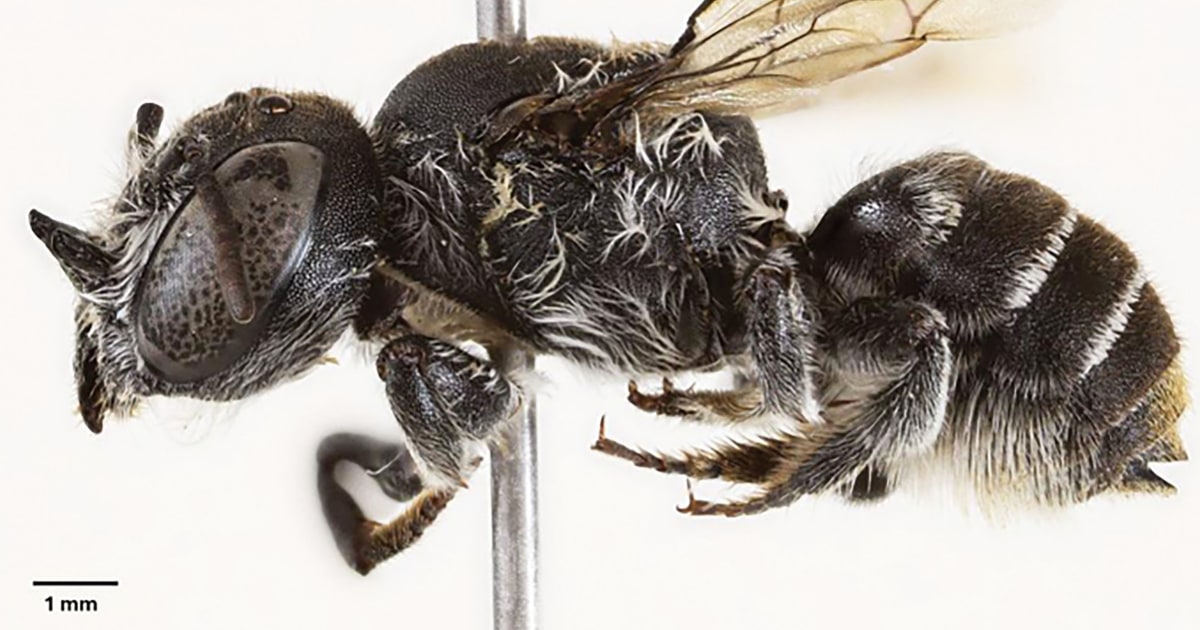Science
New ‘Lucifer’ Bee Species Discovered in Australia with Distinctive Horns

A new species of native bee, named Megachile lucifer, has been identified in Australia, featuring distinctive tiny horns that resemble those of a devil. This discovery, made by researchers surveying a critically endangered wildflower in Western Australia’s Goldfields in 2019, has garnered attention due to the intriguing characteristics of the bee and its playful name. The findings were detailed in a study published on October 23, 2023, in the Journal of Hymenoptera Research.
The unique, upward-pointing horns, measuring approximately 0.9 millimeters, are found only on the female bees. According to Kit Prendergast, the lead author of the study and an adjunct research fellow at Curtin University, the name was inspired by a viewing of the Netflix series *Lucifer*. Prendergast explained, “When writing up the new species description, I was watching the Netflix show *Lucifer*. The name just fit perfectly.”
A subsequent DNA analysis revealed that this species does not match any known bees in existing databases, making it the first new member of the Megachile group to be described in over two decades. While the exact functions of the horns remain uncertain, researchers speculate that they may assist in accessing flowers, competing for resources, and defending nests. Notably, the male bees of this species do not possess horns.
Concerns Over Habitat and Conservation
The discovery of Megachile lucifer underscores the urgent need to study Australia’s native bees, which face threats from habitat disturbance and climate change. Prendergast cautioned that without a comprehensive understanding of existing native bee species and their plant dependencies, there is a risk of losing both before they are even recognized. “Without knowing which native bees exist and what plants they depend on, we risk losing both before we even realize they’re there,” she stated.
Australia is home to around 2,000 native bee species, with more than 300 yet to be scientifically described, according to the CSIRO, Australia’s national science agency. The country’s native bee populations are described as “understudied and data poor,” leading to significant gaps in knowledge regarding their conservation status.
Tobias Smith, a bee researcher from the University of Queensland, emphasized the need for stronger policies to protect these vital pollinators from habitat loss, inappropriate fire regimes, and the increased risks posed by megafires. Although Smith was not involved in the study, he encouraged the public to engage with their local ecosystems. “Get outside and look for some native bees and appreciate them,” he suggested.
This discovery not only adds a new species to Australia’s rich biodiversity but also serves as a reminder of the importance of preserving native habitats to ensure the survival of unique species like the lucifer bee.
-

 Technology5 months ago
Technology5 months agoDiscover the Top 10 Calorie Counting Apps of 2025
-

 Health2 months ago
Health2 months agoBella Hadid Shares Health Update After Treatment for Lyme Disease
-

 Health3 months ago
Health3 months agoErin Bates Shares Recovery Update Following Sepsis Complications
-

 Technology4 months ago
Technology4 months agoDiscover How to Reverse Image Search Using ChatGPT Effortlessly
-

 Technology1 month ago
Technology1 month agoDiscover 2025’s Top GPUs for Exceptional 4K Gaming Performance
-

 Technology2 months ago
Technology2 months agoElectric Moto Influencer Surronster Arrested in Tijuana
-

 Technology5 months ago
Technology5 months agoMeta Initiates $60B AI Data Center Expansion, Starting in Ohio
-

 Technology5 months ago
Technology5 months agoRecovering a Suspended TikTok Account: A Step-by-Step Guide
-

 Health4 months ago
Health4 months agoTested: Rab Firewall Mountain Jacket Survives Harsh Conditions
-

 Lifestyle5 months ago
Lifestyle5 months agoBelton Family Reunites After Daughter Survives Hill Country Floods
-

 Technology4 months ago
Technology4 months agoHarmonic Launches AI Chatbot App to Transform Mathematical Reasoning
-

 Technology3 months ago
Technology3 months agoUncovering the Top Five Most Challenging Motorcycles to Ride





















